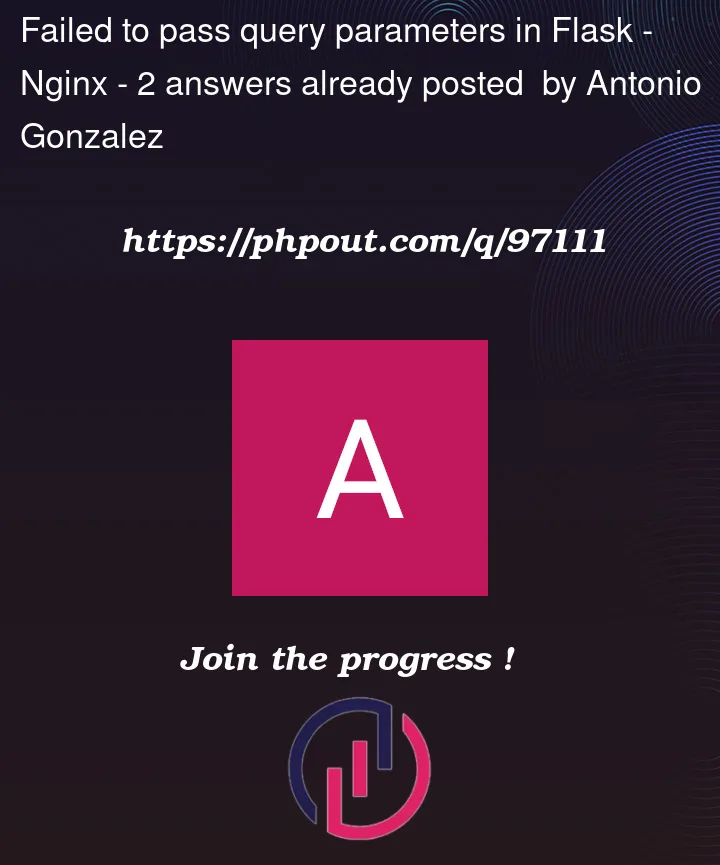My set-up is as follows:
- Flask app with custom domain and Nginx to make it more easy for HTTPS traffic
- FastApi to which flask asks for data
I have a login page that returns an authorization token (maybe not the best for security but testing for small project) my login method in Flask is able to catch this auth_token and redirects to another page that with the auth_token as query parameters does something.
Code for each function is as follows:
@app.route("/login", methods=["GET", "POST"])
def login():
if request.method == "POST":
# Forward the request to the FastAPI application running on port 8000
try:
user = request.form.get('user')
password = request.form.get('password')
# Make a request to the FastAPI endpoint
response = requests.post('http://python-fastapi:8000/login', params={'user': user, 'password': password})
response_data = response.json()
if response.status_code != 200:
# Catch detail in HTTPException
raise Exception(response_data["detail"])
return redirect("/dashboard?auth_token="+response_data["token"])
except Exception as e:
return jsonify({"status": "error", "message": str(e)}), 500
else:
return render_template("login.html")
@app.route("/dashboard")
def dashboard():
auth_token = request.get("auth_token")
# Get important information from the FastAPI application and render it in the dashboard
try:
response = requests.get('http://python-fastapi:8000/datasets', params={'auth_token': auth_token})
if response.ok:
data = response.json()
return {"data": data}
else:
data = response.json()
return {"error": data["detail"] + str(auth_token)}
except Exception as e:
return {"error": str(e)}
And if it is useful my nginx config:
server {
listen 80;
server_name automl.ddns.net;
# This just redirects if you go through http
return 301 https://$host$request_uri;
}
server {
listen 443 ssl;
server_name automl.ddns.net;
resolver 127.0.0.11 valid=10s;
resolver_timeout 5s;
ssl_certificate /etc/letsencrypt/live/automl.ddns.net/fullchain.pem;
ssl_certificate_key /etc/letsencrypt/live/automl.ddns.net/privkey.pem;
include /etc/letsencrypt/options-ssl-nginx.conf;
ssl_dhparam /etc/letsencrypt/ssl-dhparams.pem;
# Redirect any HTTP requests to HTTPS
if ($scheme != "https") {
return 301 https://$server_name$request_uri;
}
# Proxy requests to the Flask app running on port 5000
location ~ ^/(.*)$ {
proxy_pass http://python-flask:5000/$request_uri;
proxy_set_header Host $host;
proxy_set_header X-Real-IP $remote_addr;
proxy_set_header X-Forwarded-For $proxy_add_x_forwarded_for;
}
}
It is all mounted in Dockers with the following docker-compose.yml
version: '3.7'
services:
mongo:
image: mongo:latest
container_name: mongodb
restart: always
ports:
- "27017:27017"
volumes:
- ./data:/data/db
python-fastapi:
build:
context: .
dockerfile: DockerFile-fastapi
container_name: python-fastapi
restart: always
command: python3 fastapi_client.py
depends_on:
- mongo
python-flask:
build:
context: .
dockerfile: DockerFile-flask
container_name: python-flask
restart: always
command: python3 flask_app.py
depends_on:
- mongo
- python-fastapi
- nginx
nginx:
image: nginx:latest
container_name: nginx
restart: always
ports:
- "80:80"
- "443:443"
volumes:
- ./myapp.conf:/etc/nginx/conf.d/myapp.conf
- ./ssl:/etc/ssl
- ./data/certbot/conf:/etc/letsencrypt
- ./data/certbot/www:/var/www/certbot
mongo-express:
image: mongo-express
container_name: mongo-express
restart: always
ports:
- "8081:8081"
environment:
ME_CONFIG_MONGODB_SERVER: mongodb
depends_on:
- mongo
It’s my first project building frontend with an API backend so apart from the problem I have any advice is appreciated
I have tried many changes in the nginx config and on how the redirect is performed from the login to the dashboard is performed but none works.
With debug I have checked that the URL that is getting to /dashboard does not have query_parameters making auth_token to be a None.
My idea is that nginx may be blocking something but I don´t actually know. For the ngix config I have tried to change the proxy_server to proxy_pass http://python-flask:5000/$1$is_args$args with no success.
EDIT 1:
I add to the question the corresponding FastAPI implementations.
# Create endpoint to get token after login
@app.post("/login")
async def login(user: str, password: str):
# Check that username is alphanumeric
if not user.isalnum():
raise HTTPException(status_code=status.HTTP_400_BAD_REQUEST, detail="Username must be alphanumeric")
# Check that password is alphanumeric
if not password.isalnum():
raise HTTPException(status_code=status.HTTP_400_BAD_REQUEST, detail="Password must be alphanumeric")
# Check that username is in the database
if not users_collection.find_one({"user": user}):
raise HTTPException(status_code=status.HTTP_400_BAD_REQUEST, detail="Username not found")
# Check that password is correct
if not users_collection.find_one({"user": user, "password": sha256(password.encode()).hexdigest()}):
raise HTTPException(status_code=status.HTTP_400_BAD_REQUEST, detail="Password is incorrect")
# Change with time.time()
token = sha256((user + password+str(time.time())).encode()).hexdigest()
# Save the session in mongodb
session_collection.insert_one({"token": token, "user": user})
return {"status": "ok", "message": "User logged in successfully", "token": token}
@app.get("/datasets")
async def datasets(auth_token: str):
if auth_token is None:
raise HTTPException(status_code=status.HTTP_401_UNAUTHORIZED, detail="You need to provide an auth_token")
session = session_collection.find_one({"token": auth_token})
# Must only get one user in session
if len(session["user"]) != 1:
raise HTTPException(status_code=status.HTTP_500_INTERNAL_SERVER_ERROR, detail="There is more than one user in the session")
for sess in session:
user_id = sess["user"]
datasets = datasets_collection.find({"user": user_id})
# Check length of datasets
if len(datasets) == 0:
return []
result = []
for dataset in datasets:
# Load pickle
ds = Dataset.from_mongo(dataset["dataset"])
result.append({"id": str(dataset["_id"]), "name": ds.name})




2
Answers
Okay, I was overthinking the problem.
The actual problem was that the request in the HTML was not passing the query parameters.
I feel so dumb.
I re-wrote your
loginfunction with a few modifications and questions. This isn’t a full solution, but should get you on the right track.The
loginfunction depends on user & password being set, so don’t fall back on defaults using therequest.form.get()function. If those params are missing, exit with a specific error.I don’t know how your fast-api/login end point is configured, but
params=are usually for GET requests, while POST usesdata=/json=.The requests module contains a handy error catching function:
raise_for_status. This will catch any "bad" responses, not just status != 200. It’s important, particularly in debugging, not to obscure the actual error. If you get errorx, don’t catch it and log errory– log the actual error, so you know what actually went wrong.I’d do something similar in your
dashboard()function as well – don’t obscure the actual error, print it.